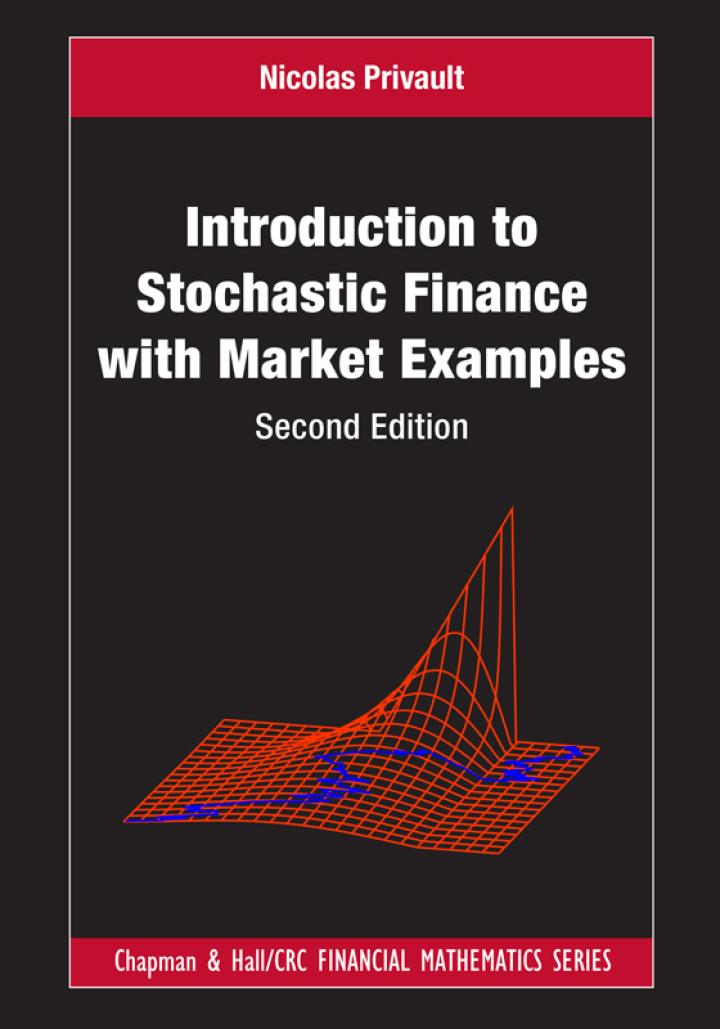Quantile hedging (Fllmer and Leukert (1999), (S 6.2) of Mel'nikov et al. (2002)). Recall that given two
Question:
Quantile hedging (Föllmer and Leukert (1999), \(\S 6.2\) of Mel'nikov et al. (2002)). Recall that given two probability measures \(\mathbb{P}\) and \(\mathbb{Q}\), the Radon-Nikodym density \(\mathrm{d} \mathbb{P} / \mathrm{d} \mathbb{Q}\) links the expectations of random variables \(F\) under \(\mathbb{P}\) and under \(\mathbb{Q}\) via the relation
\[
\begin{aligned}
\mathbb{E}_{\mathbb{Q}}[F] & =\int_{\Omega} F(\omega) \mathrm{d} \mathbb{Q}(\omega) \\
& =\int_{\Omega} F(\omega) \frac{\mathrm{d} \mathbb{Q}}{\mathrm{d} \mathbb{P}}(\omega) \mathrm{d} \mathbb{P}(\omega) \\
& =\mathbb{E}_{\mathbb{P}}\left[F \frac{\mathrm{d} \mathbb{Q}}{\mathrm{d} \mathbb{P}}ight]
\end{aligned}
\]
a) Neyman-Pearson Lemma. Given \(\mathbb{P}\) and \(\mathbb{Q}\) two probability measures, consider the event
\[
A_{\alpha}:=\left\{\frac{\mathrm{d} \mathbb{P}}{\mathrm{d} \mathbb{Q}}>\alphaight\}, \quad \alpha \geqslant 0
\]
Show that for \(A\) any event, \(\mathbb{Q}(A) \leqslant \mathbb{Q}\left(A_{\alpha}ight)\) implies \(\mathbb{P}(A) \leqslant \mathbb{P}\left(A_{\alpha}ight)\).
Hint: Start by proving that we always have
\[
\begin{equation*}
\left(\frac{\mathrm{d} \mathbb{P}}{\mathrm{d} \mathbb{Q}}-\alphaight)\left(2 \mathbb{1}_{A_{\alpha}}-1ight) \geqslant\left(\frac{\mathrm{d} \mathbb{P}}{\mathrm{d} \mathbb{Q}}-\alphaight)\left(2 \mathbb{1}_{A}-1ight) \tag{7.54}
\end{equation*}
\]
b) Let \(C \geqslant 0\) denote a nonnegative claim payoff on a financial market with risk-neutral measure \(\mathbb{P}^{*}\). Show that the Radon-Nikodym density
\[
\begin{equation*}
\frac{\mathrm{d} \mathbb{Q}^{*}}{\mathrm{dP}^{*}}:=\frac{C}{\mathbb{E}_{\mathbb{P}^{*}}[C]} \tag{7.55}
\end{equation*}
\]
defines a probability measure \(\mathbb{Q}^{*}\).
Hint: Check first that \(\mathrm{dQ}^{*} / \mathrm{dP}^{*} \geqslant 0\), and then that \(\mathbb{Q}^{*}(\Omega)=1\). In the following questions we consider a nonnegative contingent claim with payoff \(C \geqslant 0\) and maturity \(T>0\), priced \(\mathrm{e}^{-r T} \mathbb{E}_{\mathbb{P}^{*}}[C]\) at time 0 under the risk-neutral measure \(\mathbb{P}^{*}\).
Budget constraint. In what follows we will assume that no more than a certain fraction \(\beta \in\) \((0,1]\) of the claim price \(\mathrm{e}^{-r T} \mathbb{E}_{\mathbb{P}^{*}}[C]\) is available to construct the initial hedging portfolio \(V_{0}\) at time 0 .
Since a self-financing portfolio process \(\left(V_{t}ight)_{t \in \mathbb{R}_{+}}\)started at \(V_{0}:=\beta \mathrm{e}^{-r T} \mathbb{E}_{\mathbb{P}^{*}}[C]\) may fall short of hedging the claim \(C\) when \(\beta<1\), we will attempt to maximize the probability \(\mathbb{P}\left(V_{T} \geqslant Cight)\) of successful hedging, or, equivalently, to minimize the shortfall probability \(\mathbb{P}\left(V_{T}
For this, given \(A\) an event we consider the self-financing portfolio process \(\left(V_{t}^{A}ight)_{t \in[0, T]}\) hedging the claim \(C \mathbb{1}_{A}\), priced \(V_{0}^{A}=\mathrm{e}^{-r T} \mathbb{E}_{\mathbb{P}^{*}}\left[C \mathbb{1}_{A}ight]\) at time 0 , and such that \(V_{T}^{A}=C \mathbb{1}_{A}\) at maturity \(T\).
c) Show that if \(\alpha\) satisfies \(\mathbb{Q}^{*}\left(A_{\alpha}ight)=\beta\), the event
\[
A_{\alpha}=\left\{\frac{\mathrm{d} \mathbb{P}}{\mathrm{d} \mathbb{Q}^{*}}>\alphaight\}=\left\{\frac{\mathrm{d} \mathbb{P}}{\mathrm{d} \mathbb{P}^{*}}>\alpha \frac{\mathrm{d} \mathbb{Q}^{*}}{\mathrm{dP}^{*}}ight\}=\left\{\frac{\mathrm{d} \mathbb{P}}{\mathrm{d} \mathbb{P}^{*}}>\frac{\alpha C}{\mathbb{E}_{\mathbb{P}^{*}}[C]}ight\}
\]
maximizes \(\mathbb{P}(A)\) over all possible events \(A\), under the condition
\[
\begin{equation*}
\mathrm{e}^{-r T} \mathbb{E}_{\mathbb{P}^{*}}\left[V_{T}^{A}ight]=\mathrm{e}^{-r T} \mathbb{E}_{\mathbb{P}^{*}}\left[C \mathbb{1}_{A}ight] \leqslant \beta \mathrm{e}^{-r T} \mathbb{E}_{\mathbb{P}^{*}}[C] \tag{7.56}
\end{equation*}
\]
Hint: Rewrite Condition (7.56) using the probability measure \(\mathbb{Q}^{*}\), and apply the Neyman-Pearson Lemma of Question (a) to \(\mathbb{P}\) and \(\mathbb{Q}^{*}\).
d) Show that \(\mathbb{P}\left(A_{\alpha}ight)\) coincides with the successful hedging probability
\[
\mathbb{P}\left(V_{T}^{A_{\alpha}} \geqslant Cight)=\mathbb{P}\left(C \mathbb{1}_{A_{\alpha}} \geqslant Cight),
\]
i.e. show that
\[
\mathbb{P}\left(A_{\alpha}ight)=\mathbb{P}\left(V_{T}^{A_{\alpha}} \geqslant Cight)=\mathbb{P}\left(C \mathbb{1}_{A_{\alpha}} \geqslant Cight) .
\]
Hint: To prove an equality \(x=y\) we can show first that \(x \leqslant y\), and then that \(x \geqslant y\). One inequality is obvious, and the other one follows from Question (c).
e) Check that the self-financing portfolio process \(\left(V_{t}^{A_{\alpha}}ight)_{t \in[0, T]}\) hedging the claim with payoff \(C \mathbb{1}_{A_{\alpha}}\) uses only the initial budget \(\beta \mathrm{e}^{-r T} \mathbb{E}_{\mathbb{P}^{*}}[C]\), and that \(\mathbb{P}\left(V_{T}^{A_{\alpha}} \geqslant Cight)\) maximizes the successful hedging probability.
In the next Questions (f)-(j) we assume that \(C=\left(S_{T}-Kight)^{+}\)is the payoff of a European option in the Black-Scholes model
\[
\begin{equation*}
d S_{t}=r S_{t} d t+\sigma S_{t} d B_{t} \tag{7.57}
\end{equation*}
\]
with \(\mathbb{P}=\mathbb{P}^{*}, \mathrm{~d} \mathbb{P} / \mathrm{d} \mathbb{P}^{*}=1\), and
\[
\begin{equation*}
S_{0}:=1 \quad \text { and } \quad r=\frac{\sigma^{2}}{2}:=\frac{1}{2} \tag{7.58}
\end{equation*}
\]
f) Solve the stochastic differential equation (7.57) with the parameters (7.58).
g) Compute the successful hedging probability
\[
\mathbb{P}\left(V_{T}^{A_{\alpha}} \geqslant Cight)=\mathbb{P}\left(C \mathbb{1}_{A_{\alpha}} \geqslant Cight)=\mathbb{P}\left(A_{\alpha}ight)
\]
for the claim \(C=:\left(S_{T}-Kight)^{+}\)in terms of \(K, T, \mathbb{E}_{\mathbb{P}^{*}}[C]\) and the parameter \(\alpha>0\).
h) From the result of Question (g), express the parameter \(\alpha\) using \(K, T, \mathbb{E}_{\mathbb{P}^{*}}[C]\), and the successful hedging probability \(\mathbb{P}\left(V_{T}^{A_{\alpha}} \geqslant Cight)\) for the claim \(C=:\left(S_{T}-Kight)^{+}\).
i) Compute the minimal initial budget \(\mathrm{e}^{-r T} \mathbb{E}_{\mathbb{P}^{*}}\left[C \mathbb{1}_{A_{\alpha}}ight]\) required to hedge the claim \(C=\) \(\left(S_{T}-Kight)^{+}\)in terms of \(\alpha>0, K, T\) and \(\mathbb{E}_{\mathbb{P}^{*}}[C]\).
j) Taking \(K:=1, T:=1\) and assuming a successful hedging probability of \(90 \%\), compute numerically:
i) The European call price \(\mathrm{e}^{-r T} \mathbb{E}_{\mathbb{P} *}\left[\left(S_{T}-Kight)^{+}ight]\)from the Black-Scholes formula.
ii) The value of \(\alpha>0\) obtained from Question (h).
iii) The minimal initial budget needed to successfully hedge the European claim \(C=\) \(\left(S_{T}-Kight)^{+}\)with probability \(90 \%\) from Question (i).
iv) The value of \(\beta\), i.e. the budget reduction ratio which suffices to successfully hedge the claim \(C=:\left(S_{T}-Kight)^{+}\)with \(90 \%\) probability.
Step by Step Answer:

Introduction To Stochastic Finance With Market Examples
ISBN: 9781032288277
2nd Edition
Authors: Nicolas Privault





